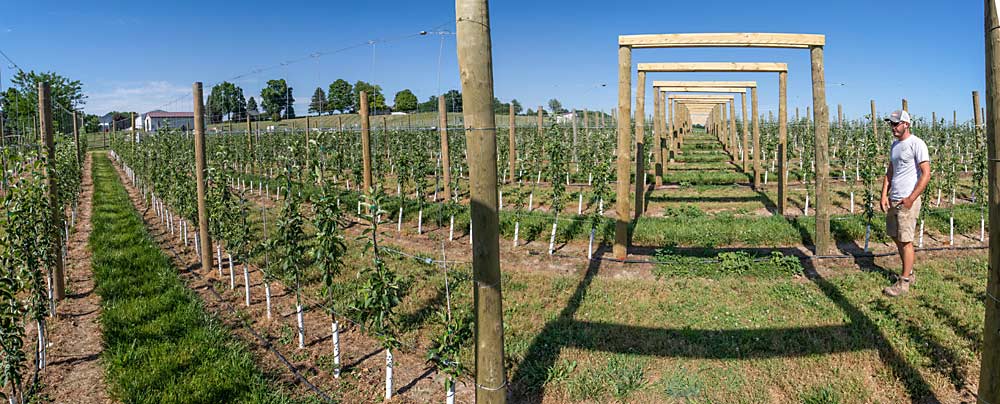
To trellis or not to trellis?
That is the question for U-pick growers. When planting a new U-pick block, should they stick with the romance of freestanding trees or choose the efficiencies of tighter spacings, posts and wires?
In Good Fruit Grower interviews, more U-pick growers said they were choosing high-density, trellised trees. As with commercial blocks, trellised U-pick trees are more expensive to install and require more labor up front, but they also yield apples sooner and are easier to manage in the long run. And customers adapt to them.
“People are used to seeing freestanding apple trees, but when they come out and see a tall spindle system, and it’s just a red wall of apples, they think it’s amazing,” said grower Nate Krause of Swans Trail Farms in Snohomish, Washington. “They’ve never seen apples grown like this.”
Grower Noah Roth expressed similar sentiments. His family’s agritourism business, Red Barn Market in Lowell, Michigan, recently planted its first U-pick block — 2.5 acres of super-spindle trees.
“We wanted to have a nice location for people to U-pick, almost like a teaching orchard,” Roth said. “People say they had no idea apples can be planted so tight.”
Educating customers wasn’t the main reason for choosing trellises over freestanding trees. Roth wanted higher yields and a quicker return on investment. He expects the block to reach nearly full production within three years of planting the bench-grafted trees, he said.
The block contains 27 varieties, with trees spaced 18 inches apart in rows alternating between 6 feet and 9 feet apart (allowing tractors and other equipment down the wider rows), all on Budagovsky 9 rootstock. Their plan is to limit the trees to 7 feet in height, so customers won’t need ladders, Roth said.
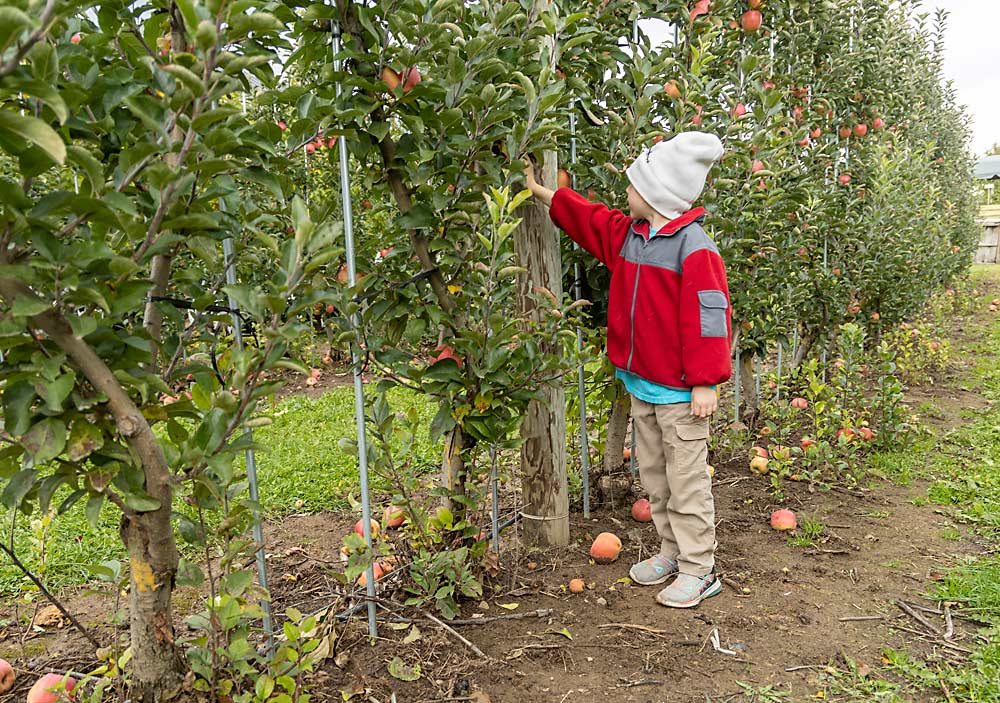
About 30 miles northwest in Sparta, Michigan, grower Phil Schwallier prefers trellised U-pick blocks, too. His farm market, Schwallier’s Country Basket, has about 15 U-pick acres, two-thirds of them on trellises. His freestanding trees are about 20 years old, spaced 6 feet by 14 feet and ranging in height from 12 to 15 feet. When the time comes to replant them, he’ll replace them with trellised trees. His latest U-pick planting was NY 1 (marketed as SnapDragon), planted 2 feet by 12 feet, he said.
Schwallier prefers the efficiencies, and quicker yields, of high-density plantings. He also thinks trellised trees are safer. U-pick customers are sometimes tempted to pick apples off the tops of freestanding trees, which makes him nervous.
“If they bust off limbs, or fall off a crate or ladder, it’s my fault,” he said.
High-density plantings can also be an advantage when land is at a premium. Swans Trail Farms, about 30 minutes north of Seattle, is one of the few U-pick orchards in a region of 4 million people. Due to land constraints, the farm is limited to about 5 acres of U-pick trees. They run out of apples every year, Krause said.
To grow more apples, their trellised U-pick trees are spaced with 30 to 36 inches between trees and 11 feet between rows. They grow the trees about 10 feet tall and pick the top 3 feet for on-farm store sales; 7 feet and lower is for U-pickers, Krause said.
Swans Trail has a wedding area surrounded by trellised Jonagold trees. The posts, wires and trees not only serve a decorative function, but they also help to restrict people to the wedding area, he said.
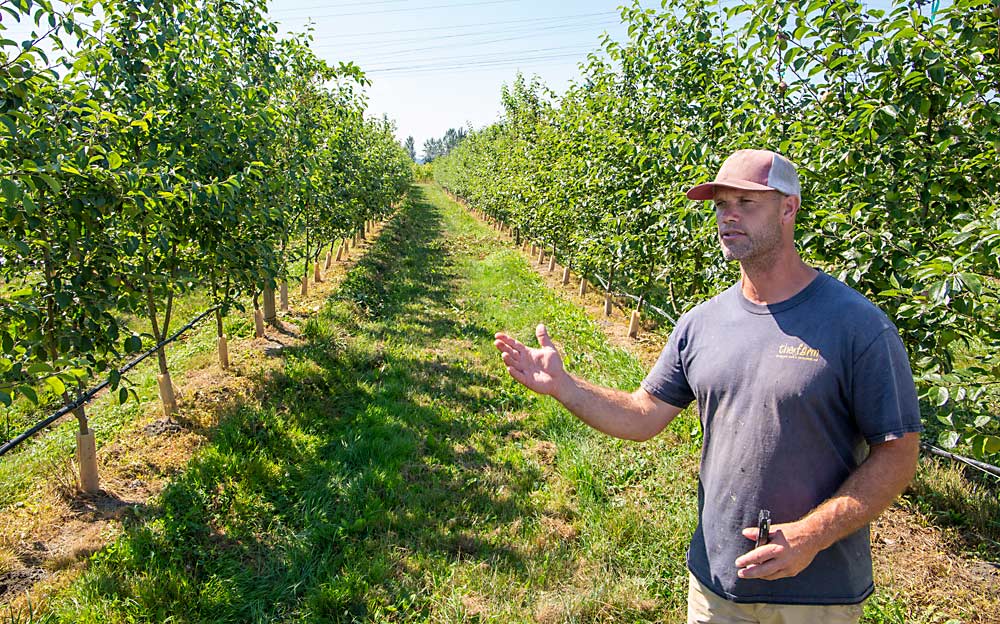
Chudleigh’s, a large agritourism farm located about 30 miles west of Toronto, Canada, also hosts lots of visitors — and also has no room to expand. Even though Chudleigh’s grows 55 acres of U-pick apples, its U-pick blocks are always jammed with customers during harvest season, said orchard manager Riley Bruce.
All the trees are trellised, spaced 22 inches apart for greater production and fruit quality, with 13 feet between rows so customers have enough room to pass each other. All new plantings are on Geneva 935 rootstock, Bruce said.
Since the farm has run out of land for new plantings, they plan to expand vertically. They let the trees grow to 12 feet, and they might go as high as 13 or 14 feet. Farm employees pick the tops for commercial sales, he said.
Trellises have gone from two wires to five wires in the newest plantings, held up by concrete posts. The extra wires provide more support. They also discourage customers from moving between rows. Chudleigh’s prefers that customers move down one side of a row and not cut between trees, to ensure they’re getting the best apples available, Bruce said.
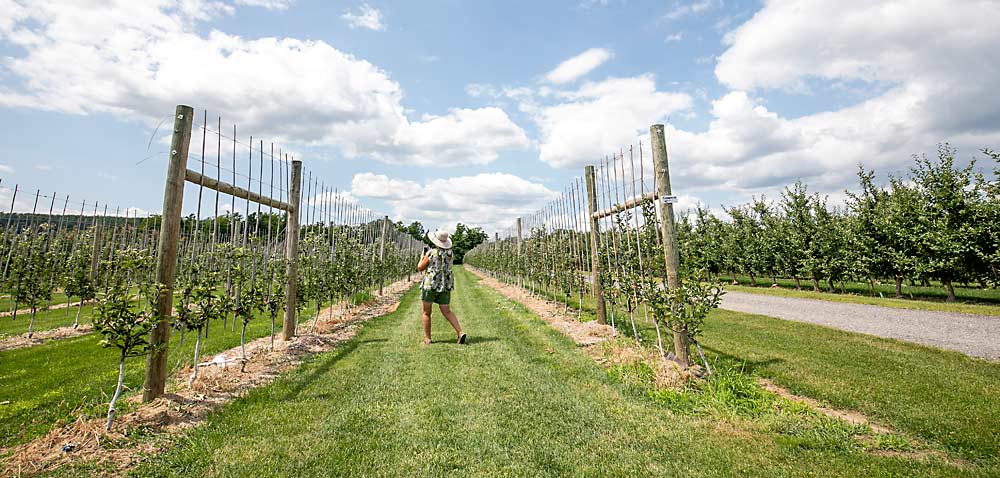
Schwallier doesn’t mind customers moving between rows, and he said greater mobility makes tree maintenance easier. His trellised blocks have wires at 5 feet, 6.5 feet, and 8 feet high. When the trees are big enough, he plans to take out the lower wires, to make it easier to move between rows, he said.
Chuck Souther’s customers like to wander between rows and don’t want to be constrained by wires. That’s why he still prefers freestanding trees.
“In a retail business, you have to listen to your customers,” he said.
Souther grows about 26 acres of U-pick apples at Apple Hill Farm in Concord, New Hampshire. His latest U-pick block was planted in 2021: freestanding EverCrisp, Gala and Ambrosia trees, spaced 8 feet by 18 feet. He expects the trees to be pickable by their fourth year. He plans to keep them about 10 feet tall. Farm employees will pick the tops as needed, he said.
Souther is open to changing his mind about trellises. He has a couple of young employees who are very interested in high-density U-pick plantings, and they might talk him into trying it.
“I get it, horticulturally,” he said. “Higher production and less acreage would appeal to me.”
Souther’s oldest trees are 42 years old — McIntosh on Malling 7. They’re 16 feet tall, with 25 feet between rows. They’re tough to manage and will have to be replaced eventually, he said.
“Customers like the romance of big, old trees,” he said. “But we’re getting tired of pruning them.”
—by Matt Milkovich

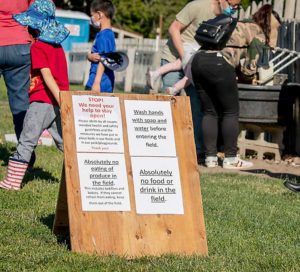
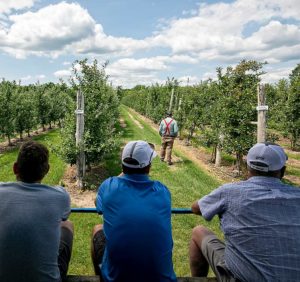





Leave A Comment